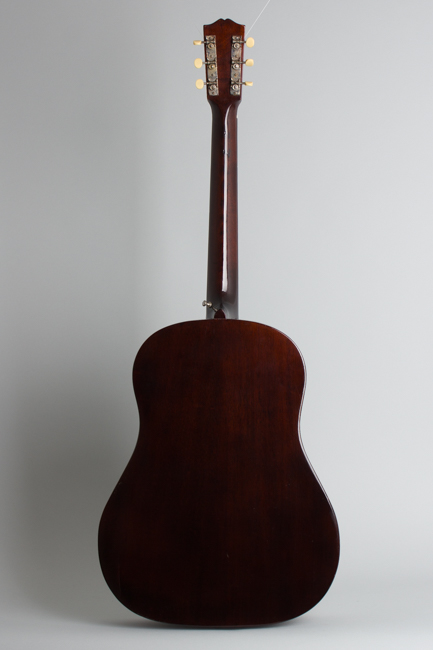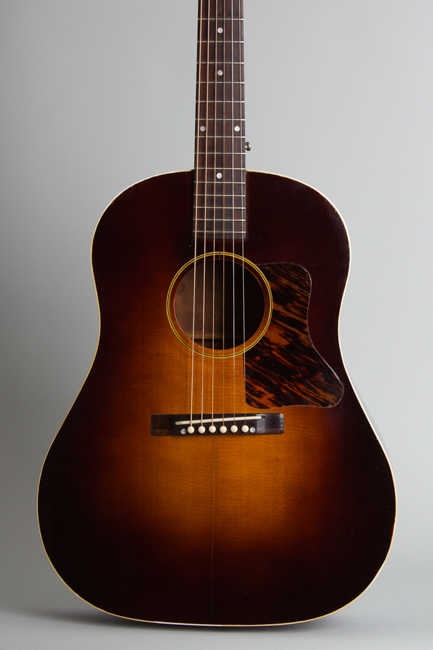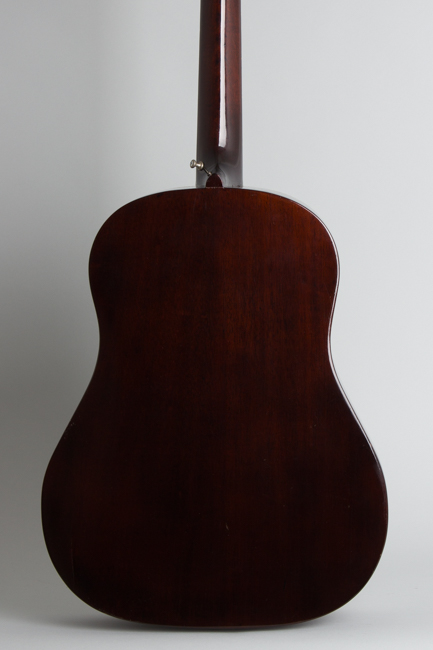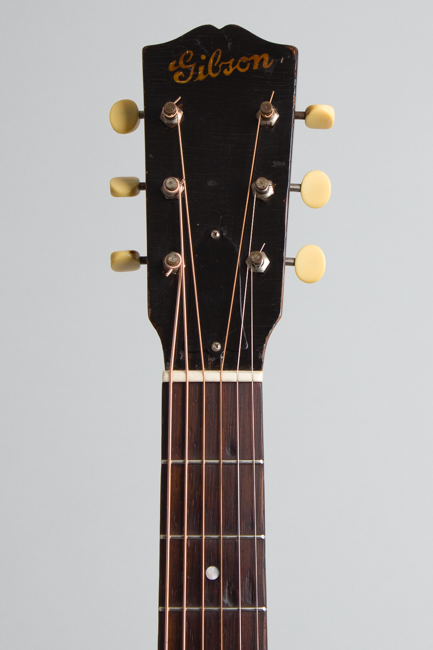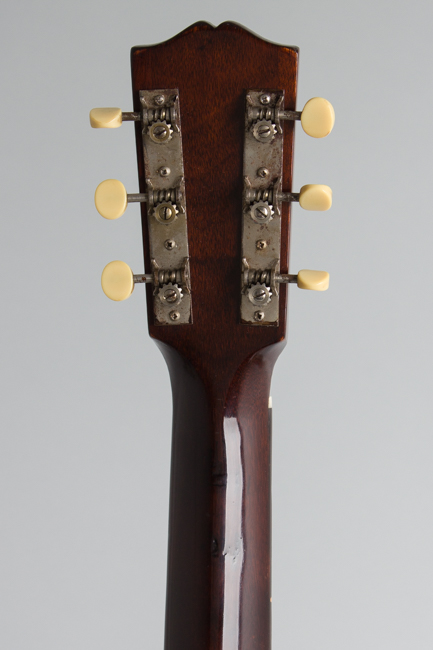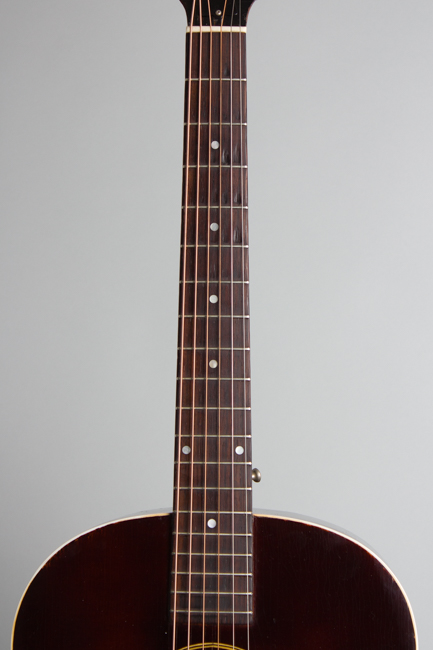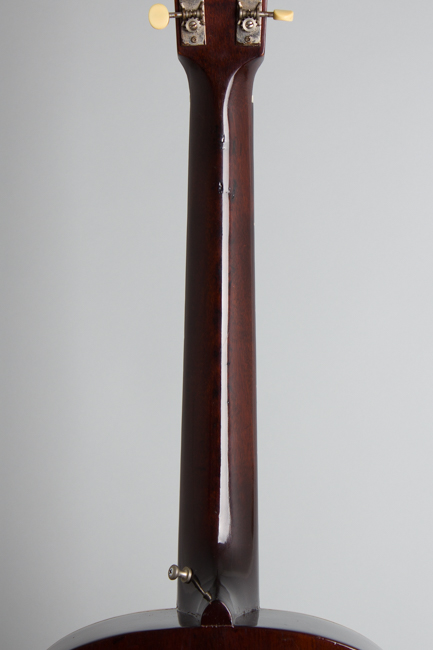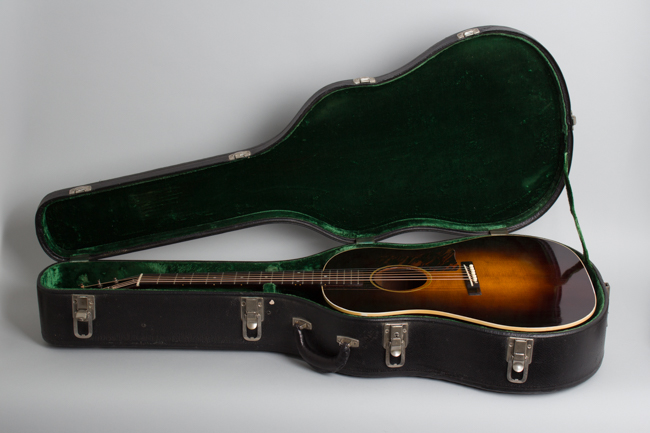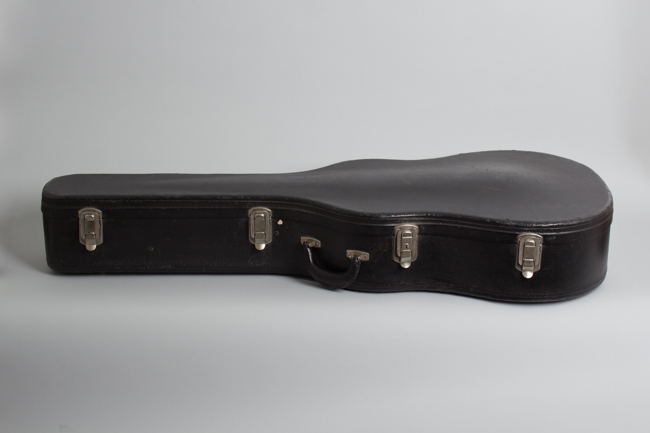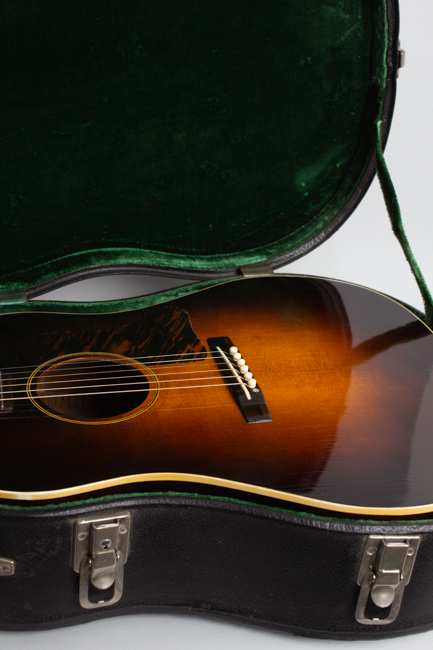Gibson Jumbo 35/Trojan Flat Top Acoustic Guitar (1936)
Gibson Jumbo 35/Trojan Model Flat Top Acoustic Guitar (1936), made in Kalamazoo, Michigan, serial # 961B-21, sunburst top, dark back and sides finish, mahogany back, sides and neck; spruce top, rosewood fingerboard, black hard shell case.
This is an extremely rare Gibson flat top, re-worked somewhat over the last nearly 90 years but an excellent playing instrument. This large bodied, slope shoulder guitar is an example of how evolution can be messy, be it biological or industrial. Every major instrument builder's history has briefly produced "transitional" instruments that stray outside the expected norms but are nevertheless important -- even pivotal -- parts of the story. Now as fretted instrument history has become an obsession, these undocumented oddities take on an almost mythical fascination.
This is a prime example. It can be called either a "Trojan" or a "Jumbo 35"; Gibson records show both names. It IS the evolutionary step between the original 1934 Jumbo flat top and the later, familiar J-35 built up into the early '40s. This transitional guitar combines earlier and later features, making for a superb instrument in its own right. It has seen some work over the years, but is still a spectacular find.
In 1934 Gibson introduced the original "Jumbo", a 16" wide, round shouldered flat top that became the progenitor of this still-popular iconic Gibson design. Unfortunately it was priced at $60, a LOT of cash in depression dollars. Sales were poor, and by mid-1936 the design was recast as two guitars; an $80 deluxe rosewood "Advanced Jumbo" with fancy cosmetics for the professionals and this, a $35 reduction of the Jumbo formula to its most minimal essentials.
This is where the naming anomaly comes in. Starting October 27 1936 and ending on December 17, entries appear in Gibson's ledgers showing guitars shipped under the name "Trojan". After that "Jumbo 35" appears instead. The reason for the change is lost to history. National had a "Trojan" for a wood body resonator guitar in the catalog since 1933; they may have complained to Gibson just as Gretsch later did to Fender over the "Broadcaster" trademark. Perhaps Gibson's management decided the name strayed too far from established Gibson letter/number naming conventions and simply axed it. Maybe someone noticed "Trojan" had been a popular brand of condoms since the 1910s. For whatever reason the "Trojan" moniker was never advertised, appearing briefly in shipping records before being replaced with "Jumbo 35" and then simply "J-35".
This guitar bears factory order number 961B-21 on the heelblock. As far as can be determined two sequential batches 960B and 961B are the first examples built in mid-1936. If built technically as a Trojan, by the time it was verifiably sold that name was obsolete. 961B-21 appears to have been shipped as a "Jumbo 35" in a #118 (chipboard) case to Pearson Music in Virginia on Sept 7, 1937. This implies it sat in stock for something like a year before being sold, or had previously been shipped out to and back from another dealer (fairly common in this period). It was soon shipped back to Gibson for an unspecified repair; the FON was recorded when it was returned to Pearson on Dec 30, 1937.
Structurally this guitar combines elements of the original 1934 Jumbo and the subsequent early J-35. The body is a nearly uniform depth, tapering very slightly from 4 1/2" at the endpin to 4 1/4" by the neck heel. There is no back binding, a characteristic of the earliest models. The spruce top is single bound and has a slightly wider 4" soundhole verses the 3 3/4" used on the Jumbo, with a 3-ply celluloid ring. It carries scalloped X bracing with two scalloped tone bars; there is some variation in this but three tone bars is the more common configuration. The small rosewood bridge is the typical Gibson fitting.
The neck is slimmer than most Jumbos we have handled (with an almost "AJ" feel) but retains a noticeable V profile and a nut width just a hair under 1 3/4". It carries an unbound, dot inlaid rosewood fingerboard. The headstock is fitted with the very earliest flat-plate Kluson strip tuners and marked with the typical script stencil Gibson logo. This is the only one of these transitional Trojan/Jumbo 35s we have ever had. It is a very comfortable guitar to play, feeling not like either a typical 1934 Jumbo of a later J-35. While the guitar has seen some external finish work its structure and original character remain intact, a true Unicorn of a Kalamazoo flat top.
Overall length is 41 in. (104.1 cm.), 16 in. (40.6 cm.) wide at lower bout, and 4 1/2 in. (11.4 cm.) in depth at side, taken at the end block. Scale length is 24 3/4 in. (629 mm.). Width of nut is 1 23/32 in. (44 mm.).
This extremely rare instrument remains structurally excellent but has seen some visible work done over the last nearly 90 years. It has a near complete clear lacquer overspray on both body and neck, which looks to have been applied some time ago. The original finish appears largely intact underneath, including the dark sunburst top and somewhat "smoked" original Gibson headstock logo. There is some longitudinal checking (most heavily to the top) and minor wear to this over finish, and some older wear visible underneath especially to the headstock, which shows some rounded edge wear. The back of the neck has some feelable capo divots behind the first and second frets also now under the finish.
The original rosewood bridge is still intact with remnants of the original finish; it was not sprayed over. For some reason lost to history there are two tiny shallow holes drilled in the forward edge. The pickguard is likely a reproduction; at the very least appears to have been lifted and reattached. Although the "firestripe" material appears correct the edges are less rounded than we would normally expect for a period Gibson.
There are only minor structural repairs. For such a lightly built, large body instrument this guitar is remarkably free of cracks. A tight center seam separation has been sealed and cleated, there are no other cracks or damage visible. Internally all the bracing is intact and original; the only alteration is a reproduction small maple bridge plate to the correct pattern and the small center seam cleat. The original bridge bolts are still intact under the pearl dots. A strap button was added at the heel.
The guitar has had a recent neck reset, well done but leaving visible marks in the thicker finish around the heel. There is a beautifully well done refret with period correct wire; the fingerboard has some divoting in the lower positions but nothing that impedes play. The bone nut and saddle are modern replacements. This is an excellent playing guitar, and a true piece of Gibson history. The sound is brighter than some similar Jumbos, not overly loud but punchy, ringing and quite even. It resides in a somewhat later vintage HSC, the original chipboard #118 being long lost to history. Overall Very Good + Condition.
This is an extremely rare Gibson flat top, re-worked somewhat over the last nearly 90 years but an excellent playing instrument. This large bodied, slope shoulder guitar is an example of how evolution can be messy, be it biological or industrial. Every major instrument builder's history has briefly produced "transitional" instruments that stray outside the expected norms but are nevertheless important -- even pivotal -- parts of the story. Now as fretted instrument history has become an obsession, these undocumented oddities take on an almost mythical fascination.
This is a prime example. It can be called either a "Trojan" or a "Jumbo 35"; Gibson records show both names. It IS the evolutionary step between the original 1934 Jumbo flat top and the later, familiar J-35 built up into the early '40s. This transitional guitar combines earlier and later features, making for a superb instrument in its own right. It has seen some work over the years, but is still a spectacular find.
In 1934 Gibson introduced the original "Jumbo", a 16" wide, round shouldered flat top that became the progenitor of this still-popular iconic Gibson design. Unfortunately it was priced at $60, a LOT of cash in depression dollars. Sales were poor, and by mid-1936 the design was recast as two guitars; an $80 deluxe rosewood "Advanced Jumbo" with fancy cosmetics for the professionals and this, a $35 reduction of the Jumbo formula to its most minimal essentials.
This is where the naming anomaly comes in. Starting October 27 1936 and ending on December 17, entries appear in Gibson's ledgers showing guitars shipped under the name "Trojan". After that "Jumbo 35" appears instead. The reason for the change is lost to history. National had a "Trojan" for a wood body resonator guitar in the catalog since 1933; they may have complained to Gibson just as Gretsch later did to Fender over the "Broadcaster" trademark. Perhaps Gibson's management decided the name strayed too far from established Gibson letter/number naming conventions and simply axed it. Maybe someone noticed "Trojan" had been a popular brand of condoms since the 1910s. For whatever reason the "Trojan" moniker was never advertised, appearing briefly in shipping records before being replaced with "Jumbo 35" and then simply "J-35".
This guitar bears factory order number 961B-21 on the heelblock. As far as can be determined two sequential batches 960B and 961B are the first examples built in mid-1936. If built technically as a Trojan, by the time it was verifiably sold that name was obsolete. 961B-21 appears to have been shipped as a "Jumbo 35" in a #118 (chipboard) case to Pearson Music in Virginia on Sept 7, 1937. This implies it sat in stock for something like a year before being sold, or had previously been shipped out to and back from another dealer (fairly common in this period). It was soon shipped back to Gibson for an unspecified repair; the FON was recorded when it was returned to Pearson on Dec 30, 1937.
Structurally this guitar combines elements of the original 1934 Jumbo and the subsequent early J-35. The body is a nearly uniform depth, tapering very slightly from 4 1/2" at the endpin to 4 1/4" by the neck heel. There is no back binding, a characteristic of the earliest models. The spruce top is single bound and has a slightly wider 4" soundhole verses the 3 3/4" used on the Jumbo, with a 3-ply celluloid ring. It carries scalloped X bracing with two scalloped tone bars; there is some variation in this but three tone bars is the more common configuration. The small rosewood bridge is the typical Gibson fitting.
The neck is slimmer than most Jumbos we have handled (with an almost "AJ" feel) but retains a noticeable V profile and a nut width just a hair under 1 3/4". It carries an unbound, dot inlaid rosewood fingerboard. The headstock is fitted with the very earliest flat-plate Kluson strip tuners and marked with the typical script stencil Gibson logo. This is the only one of these transitional Trojan/Jumbo 35s we have ever had. It is a very comfortable guitar to play, feeling not like either a typical 1934 Jumbo of a later J-35. While the guitar has seen some external finish work its structure and original character remain intact, a true Unicorn of a Kalamazoo flat top.
Overall length is 41 in. (104.1 cm.), 16 in. (40.6 cm.) wide at lower bout, and 4 1/2 in. (11.4 cm.) in depth at side, taken at the end block. Scale length is 24 3/4 in. (629 mm.). Width of nut is 1 23/32 in. (44 mm.).
This extremely rare instrument remains structurally excellent but has seen some visible work done over the last nearly 90 years. It has a near complete clear lacquer overspray on both body and neck, which looks to have been applied some time ago. The original finish appears largely intact underneath, including the dark sunburst top and somewhat "smoked" original Gibson headstock logo. There is some longitudinal checking (most heavily to the top) and minor wear to this over finish, and some older wear visible underneath especially to the headstock, which shows some rounded edge wear. The back of the neck has some feelable capo divots behind the first and second frets also now under the finish.
The original rosewood bridge is still intact with remnants of the original finish; it was not sprayed over. For some reason lost to history there are two tiny shallow holes drilled in the forward edge. The pickguard is likely a reproduction; at the very least appears to have been lifted and reattached. Although the "firestripe" material appears correct the edges are less rounded than we would normally expect for a period Gibson.
There are only minor structural repairs. For such a lightly built, large body instrument this guitar is remarkably free of cracks. A tight center seam separation has been sealed and cleated, there are no other cracks or damage visible. Internally all the bracing is intact and original; the only alteration is a reproduction small maple bridge plate to the correct pattern and the small center seam cleat. The original bridge bolts are still intact under the pearl dots. A strap button was added at the heel.
The guitar has had a recent neck reset, well done but leaving visible marks in the thicker finish around the heel. There is a beautifully well done refret with period correct wire; the fingerboard has some divoting in the lower positions but nothing that impedes play. The bone nut and saddle are modern replacements. This is an excellent playing guitar, and a true piece of Gibson history. The sound is brighter than some similar Jumbos, not overly loud but punchy, ringing and quite even. It resides in a somewhat later vintage HSC, the original chipboard #118 being long lost to history. Overall Very Good + Condition.


